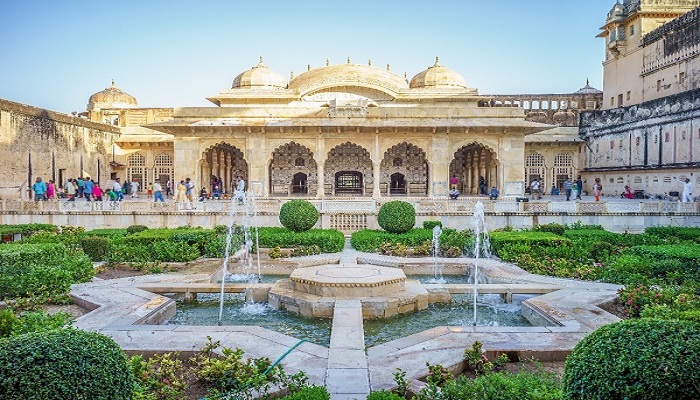Amer palace

Amer Palace (also known as Amber Fort) is a magnificent structure located in Amer, a town about 11 kilometers from Jaipur, Rajasthan. Built by Raja Man Singh I in 1592, it is one of the most important monuments of the Rajputana era, renowned for its unique blend of Rajput and Mughal architecture. The palace sits atop a hill, overlooking Maota Lake, and is a significant part of India's rich heritage.
Architecture
Amer Palace is known for its grandiose design, intricate carvings, and lavish use of red sandstone and marble. The fort's architecture reflects the opulence of the Rajput Maharajas who once ruled the region, showcasing the craftsmanship of both Hindu and Mughal artisans.
Main Courtyard (Jaleb Chowk): The fort is entered through the Sun Gate (Suraj Pol), which leads to the first courtyard, Jaleb Chowk, a large open area where armies used to parade. This courtyard also served as a gathering place for soldiers.
Ganesh Pol: The entrance to the inner palace is marked by Ganesh Pol, an elaborately painted and decorated gateway. The entrance is dedicated to Lord Ganesha, symbolizing auspiciousness and new beginnings. Above the gateway is a room adorned with stunning frescoes.
Diwan-i-Aam (Hall of Public Audience): This is where the king addressed the general public. It is a spacious hall with forty columns and delicately latticed windows. The columns are designed with intricate floral patterns and frescoes, combining Mughal artistry with Rajput design.
Diwan-i-Khas (Hall of Private Audience): A more private chamber where the king would meet with special guests and ministers, the Diwan-i-Khas is adorned with mirrors and glasswork that creates a dazzling spectacle when lit.
Sheesh Mahal (Mirror Palace): The Sheesh Mahal is the most famous part of the palace, known for its incredible use of glass. The walls and ceilings are adorned with thousands of tiny mirror pieces, arranged in beautiful patterns. Legend says that a single candle's light can illuminate the entire room because of the mirror work.
Sukh Niwas (Hall of Pleasure): The Sukh Niwas was designed to be a retreat from the heat, utilizing an ancient form of air conditioning. Water cascades through channels to cool the air, creating a pleasant atmosphere during the intense summer months.
Kesar Kyari Garden: A distinctive feature of Amer Palace is the Kesar Kyari, a Mughal-style garden in the middle of Maota Lake. The garden is planted with saffron flowers (hence its name, "Kesar") and is one of the prime examples of blending natural beauty with architectural excellence.
Legends and Stories
Legend of Raja Man Singh and Mirabai: Raja Man Singh, a chief commander in the Mughal army under Emperor Akbar, is said to have had a connection to the famous saint-poetess Mirabai, known for her devotion to Lord Krishna. One legend suggests that Mirabai once visited the palace, but her devotion was considered inappropriate by the conservative court. However, Lord Krishna is said to have miraculously appeared to her in her defense.
The Curse of Kachwahas: Amer's Kachwaha dynasty, who built the palace, is believed to have incurred a curse that prevented them from experiencing direct royal rule over Jaipur for generations. This legend is tied to a battle between the Kachwahas and their enemies, leading to betrayal and a curse that affected the family for centuries.
The Tale of Jodha Bai and Akbar: One of the most famous legends associated with Amer Palace is the marriage of Jodha Bai, the daughter of Bharmal, the Raja of Amer, to Akbar, the Mughal Emperor. While the story is more closely linked to Jaipur, the alliance between the Rajputs and the Mughals through Jodha Bai had significant political ramifications. The Amer rulers continued to serve in the Mughal court, and the palace architecture reflects this fusion of Rajput and Mughal styles.
Hidden Treasure: There is a long-standing belief that Amer Palace houses secret passages and hidden treasure. In 2011, rumors resurfaced when excavation work began in search of treasure within the palace grounds, though nothing significant was reportedly found. However, the legend adds a mysterious allure to the palace's history.
Cultural Importance
Amer Palace is not only an architectural masterpiece but also an important cultural symbol of the Rajasthan Royals. It represents the height of Rajput glory and their stronghold in northern India. Many cultural performances, such as light and sound shows, are conducted within the fort to recreate the grandeur of its history for visitors.
The fort is also listed as part of the UNESCO World Heritage Site under the "Hill Forts of Rajasthan."
https://www.youtube.com/watch?v=WxZWjpo7LWE&list=PLnitWybJir-62QGLA6LE5QA_swQ847rFG&index=5
